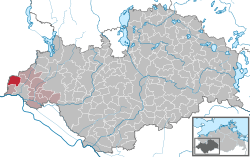Schwanheide
From Wikipedia, the free encyclopedia
| Schwanheide | |
|---|---|
 Schwanheide | |
Location of Schwanheide within Ludwigslust-Parchim district  | |
| Coordinates: 53°25′N 10°40′E / 53.417°N 10.667°ECoordinates: 53°25′N 10°40′E / 53.417°N 10.667°E | |
| Country | Germany |
| State | Mecklenburg-Vorpommern |
| District | Ludwigslust-Parchim |
| Municipal assoc. | Boizenburg-Land |
| Subdivisions | 3 |
| Government | |
| • Mayor | Gerd Altenburg |
| Area | |
| • Total | 26.51 km2 (10.24 sq mi) |
| Elevation | 17 m (56 ft) |
| Population (2012-12-31)[1] | |
| • Total | 704 |
| • Density | 27/km2 (69/sq mi) |
| Time zone | CET/CEST (UTC+1/+2) |
| Postal codes | 19258 |
| Dialling codes | 038842, 038847 |
| Vehicle registration | LWL |
| Website | www.amtboizenburgland.de |
Schwanheide is a municipality in the Ludwigslust-Parchim district, in Mecklenburg-Vorpommern, Germany.
History
Between 1945 and 1990 Schwanheide served as East German inner German border crossing for rail transport. The crossing was open for trains travelling between the Soviet Zone of occupation in Germany (till 1949, thereafter the East German Democratic Republic, or West Berlin and the British zone of occupation (till 1949) and thereafter the West German Federal Republic of Germany. The traffic was subject to the Interzonal traffic regulations, that between West Germany and West Berlin followed the special regulations of the Transit Agreement (1972).
References
- ↑ "Bevölkerungsstand der Kreise, Ämter und Gemeinden in Mecklenburg-Vorpommern 31.12.2012". Statistisches Amt Mecklenburg-Vorpommern (in German). 14 August 2013.
This article is issued from Wikipedia. The text is available under the Creative Commons Attribution/Share Alike; additional terms may apply for the media files.